Interview: Bill Barrell
Ron Morosan
October 2017
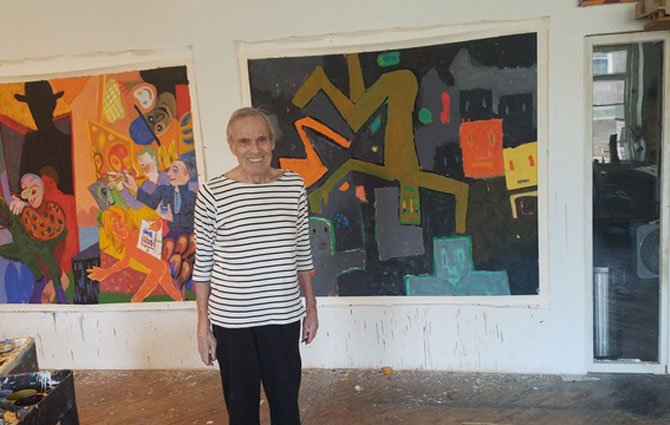 Bill Barrell in his studio
Bill Barrell in his studio
Bill Barrell: Figurative Expressionist
With the exhibition Inventing Downtown at the Grey Art Gallery of NYU, new attention is being brought to artists working in the late fifties and early sixties and creating the downtown art scene that spawned Pop Art, Minimalism, and Figurative Expressionism. While the first two groups of artists received most of the attention thanks to Richard Bellamy and Leo Castelli, other artists were not so fortunate to be taken up by the right galleries.
Though not featured in Inventing Downtown, Bill Barrell and his art represent all of the characteristic activities of those artists. He started and ran his own gallery, The Pitt Street Salon, performed in happenings by Red Grooms, and befriended and worked alongside artists including Bob Thompson, Jay Milder, Claes Oldenburg and Robert Beauchamp.
Born in London in 1932, Bill and his brother Terry arrived in the USA in 1954 with very little money, but with great hope of a new life in a new world. Over the next ten years Bill discovered his true calling as an artist and most specifically as a painter.
As an artist Bill was hungry for experience. He chose to explore all the aspects of what art was in the lifestyles it had to offer: he became a painter, collector of art, a gallerist, a creative Idea man, and a life-style enthusiast, traveling and living in Spain, St. Barts, Maine, New Jersey, and now in his present location of Easton, PA.
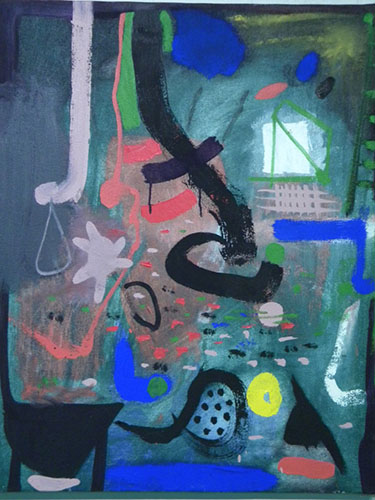 Studio Window
Studio Window
RON:
Ok, Bill, so tell me about when you arrived in the United States and how did you become settled?
BILL:
Having left London, England in 1954, I settled in Philadelphia for two years working for a wax company. While there I took a vacation to New England. I went out to the end of Cape Cod to discover Provincetown, an old art colony. I spent a week there and was transfixed by the art and artists. I had always had a feeling that there was something I should be doing and this was it. I was bitten by the art bug. I knew from the beginning it would be tough. I returned to Philly and spent my last $35.00 on art supplies. We had a basement and it became my studio. I went to an evening art class mainly for the old canvasses and free paint. I painted every evening. I was hooked.
I decided to return to Cape Cod to live in 1956. I bought a tent and camped on the beach for the whole summer. I made friends with a Portuguese carpenter who offered me an old garage as a studio. I got a job with a construction company putting in an overflow system for Pilgrim Lake. One other carpenter, Tony Vevers, was a painter. We became friends. He was older and had studied art at Yale. I had many dinners at his house with his beautiful wife Elspeth.
One day while working on the construction site, a convertible car pulled up and asked me if I knew a Bill Barrell. You are talking to him, I replied. He said, you are a painter right? I said yes. He said he would like to see my work. So I hopped into his car and we went to the garage. I had about 20-30 works and he rummaged through them. He picked out half a dozen and asked me, how much? I was flabbergasted. I had not sold a painting, so had no experience. I don’t recall the exact amount. It was about $200, s small fortune in those days. I had no idea who he was, but was later told it was Walter P. Chrysler.
I have a picture somewhere in the computer. I’ll dig it out one day. It was gifted to William and Mary University about ten years ago.
 Painting sold to Walter P. Chrysler, 1967
Painting sold to Walter P. Chrysler, 1967
RON:
What was it like in the late 50’s and early 60’s?
BILL:
Those were interesting days. There was not much money around but collectors were approachable. I had a collector, Hudson D Walker, whom I met in Provincetown. He came to the Pitt Street Salon Gallery. He bought four pieces and said I was the best artist to come along since Marsden Hartley. I would call him when I was broke and he would invite me up to his tiny office on 42 St. He dealt in diamonds. He would say come around 4:30. I would go with three or four works. He would pull out a bottle of Jack Daniels and we would talk art.
He would buy something. Last time I went he didn’t see anything he liked but said I’m sure you need some money and he wrote a check for $400.00. Those kinds of collectors seem to have evaporated. He died a year later; I lost a good collector. There is a museum somewhere in Minnesota that he started. Walter P. Chrysler was also a great collector. I had a friend who had sold a painting to Peter, Paul, and Mary. But they would not take it unless it went into a museum. I took him up to Walter P. Chrysler’s store on Madison Avenue and Chrysler took it for his museum and Peter, Paul, and Mary paid up.
It has become big business now. Soho was beginning to come alive in the late seventies. One could still buy a loft for $20,000. The last time I paid my rent $400.00 on Lafayette St. the landlady said, “Mr. Barrell, why don’t you buy the building?” She wanted $275,000. seven floors with an adjoining one story building. If I had only known what I know now. I think Pop Art had run its course and people like Basquiat were popping up. Things were changing.
Going back to the Pitt Street Salon, you ask what motivated me. Well, It was tough to find a gallery that would show my work. So the alternative was to open one’s own gallery. That’s what I should have called it. “The Alternative Gallery.” Like I have said, it was well received and motivated others to do the same. There was an article in the New York Times called Alternative Spaces that gave me good coverage. I knew the critic Peter Schjeldahl. He came to Maine for a visit and saw a happening I did in my barn called Bill Bolt and his Two Nuts. He loved it and bought a small drawing. He had given me my first review in Art News, about four lines. It was a drawing show in a gallery called The Maple Gallery on 10 St., about 1967. Another gallery I bet you never heard of. It was not around for long.
RON:
Was the development of the Beat Scene very prominent in the downtown Eastside?
BILL:
I just read an article about Sam Shepard. He lived through that period when the Lower East Side, known as the LES, was a hive of activity. I lived there from 1964 through 1972. He is right. I remember action all over the place. I worked for the woman who ran La Mama, Ellen Stewart. My brother Terry was in a play there. It was such a hyperactive time. Artists all worked for nothing, or so it seemed. I remember a party in my building and these hairy guys walked into my place. I said, “Who are you?” They said, “We are the Fugs.” I said, “ The party is upstairs.” People were doing all kinds of drugs. I smoked a little pot but that was about it.
I met Michael Zimmer about that time. When I told him I got a house for $850 he came up and got one for $5000. One night over dinner he told me of a piece of land he bought on the beach in St. Bart’s. When I suggested we do like the birdies, summer in Maine and winter in St. Bart’s his eyes lit up and he said what a great idea. We did that for three years. I think I’m an idea man. When he bought the place in Grand Manan he felt lonely. I suggested he set up a program to get artists up there. He did it and had company all summer.
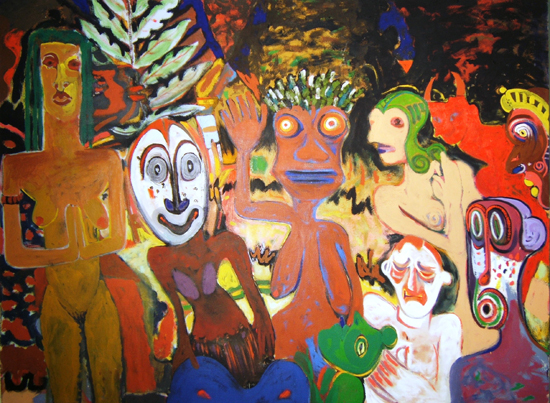 Night Guardians
Night Guardians
RON:
What were some of the ideas that influenced you and who were some of the people you met?
BILL:
My early years in Provincetown gave me a base to work from. Having no formal education in art, I had to teach myself. Hans Hoffmann had an art school in P’town, but I did not have enough money to go there. I would go by and listen to crits, his push and pull theory, which made sense. I met Red Grooms, Bob Beauchamp, Bob Thompson, and Lester Johnson around this time. They were experimenting with the figure and it intrigued me. I had done a lot of abstract paintings but was attracted to inserting the figure. It kind of brought the works to life.
In the late summer of 1958 I bought an old Railway express truck/van for $60.00. Guy I bought it from was Maggie Rose so that’s what I called it. People asked me where I was going and I told them California. They said you won’t get out of the Cape in that thing. I put a new battery in it and set off with my wife Irene Baker and a dog Alfie for California. The truck had sliding doors with two doors that opened, great for paintings.
There was a collector by the name of Murchison who had bought some large works from an artist and asked me to take them down to NYC. I charged him $100.00. It paid for the truck. I delivered them to his penthouse on Fifth Avenue where he had a gorgeous South American mistress. She was great. She doted on my wife telling her to take a bath and help herself to perfumes, and as she would be away for the weekend, we stayed in the penthouse and left for California the next day.
I’m not sure, but about this time Jack Kerouac was doing his cross country thing, On the Road. The beat generation was coming to a close, but I found it odd later that I was doing the same thing. I made it to LA. Not sure how long it took and we were in no hurry. We had a friend who lived in Malibu and stayed with him for two months. We then headed for San Francisco. Rented an old laundromat across from the Fillmore Movie Theater. Would go there for 60 cents. Three movies, bingo, and the news and it was warm. Spent three months there and did a happening. Left SF back down to LA and on to Mexico. Arrived back in Provincetown and sold the truck for $150.00.
The Sun Gallery in Provincetown was a small gallery and experimental. I knew Red Grooms and he showed there. He introduced me to everyone and Val Anderson, who ran it. Red was putting together a happening. I was intrigued and wanted to be in it but all parts were taken. But later Val got cold feet and I got the part as “The Walking Man,” the title of the show. It was a big success. Galleries were still showing Ab/Ex; that was sort of the rage.
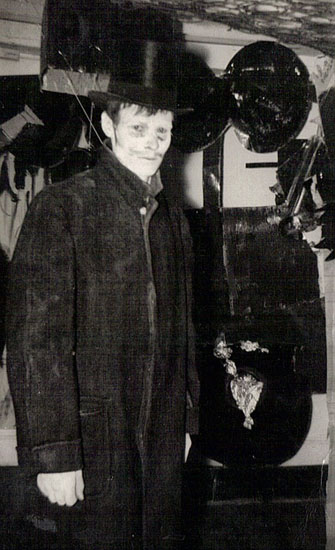 Barrell as The Walking Man at Sun Gallery, 1958
Barrell as The Walking Man at Sun Gallery, 1958
Franz Kline had moved into town. Then there were Motherwell and Hoffmann and assorted others. The one painter who lived there year round was Myron Stout. We became good friends, and although I had become a figurative expressionist, his last paintings, black and white with just a single shape, fascinated me. So simple yet so complex. It was 1959. Stayed the winter in P’town. In the dead of winter I was living on SS of $32 a week. I was in a bar one night and in walks Walter Chrysler who I have mentioned. He asked me how my work is going and sets up an appointment for the next day. He buys eight works. Total $900.00. A small fortune in those days.
Val and Evone were moving back to Boston and I took over the Sun Gallery. I continued with their experimental work. I added Claes Oldenburg, giving him his first show. We also showed Jack Smith and Ken Jacobs premiering their movie Flaming Creatures. No one else would show it. We had a show of mono-prints by Tony Vevers based on the three graces. The police came by and shut us down. It caused an uproar. That night they told us to close and that if we opened again they would jail me. I found Tony at a party that night at Fritz Bultman’s, an artist I was not fond of. He said he knew the town’s councilman and mayor and could have them take care of it. I told him in no uncertain terms that I thought that was not the way to handle it. He threw my wife and me off his property. Felt like Adam and Eve. It’s a long story. Ended with Hans Hoffmann coming to the gallery and writing a declaration of innocence. The cops said the show was pornographic. I asked what made them pornographic and they said “Anything with pubic hairs.”
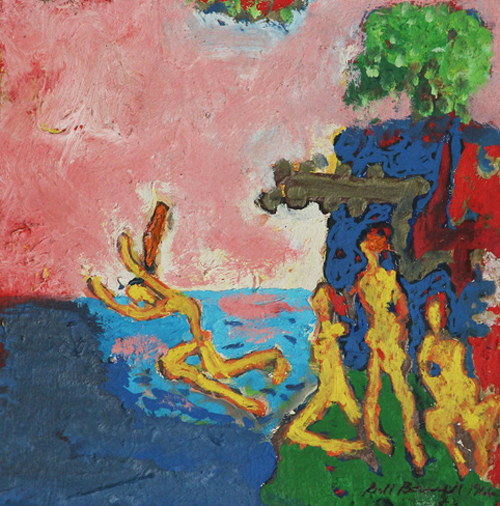 Bathers, 1966
Bathers, 1966
RON:
When did you become involved with Rhino Horn and what did the group do?
BILL:
It was a group of artists working in a figurative expressionist manner in a Pop Art world. They managed to garner some attention. I believe the first show we did was at some college in Brooklyn (Kings?). The other show I recall was at Rutgers in NJ. My work with the group was a bit peripheral. From 1973-1976, I was spending my winters in St. Bart’s and summers in Maine, so I did not have a lot of contact with them. Peter Schjeldahl reviewed a show they did in the NY Times and mentioned that a major artist in the group was missing, Bill Barrell.
I was playing on the beach. We would have meetings at Nick Spirakis’s studio. Rhino Horn was the first group to be interviewed by “Artists Talk On Art” at Bob Wiegand’s studio. The interviewer was Lester Johnson. A couple of years ago Jay Milder, Peter Passuntino, and myself were interviewed by Adam Zucker about Rhino Horn and art today. It was filmed and recorded. My feelings about the group were a bit ambivalent.
I don’t know how the name came about. I think they saw themselves as tough and maybe horny. I think Peter had a hand in it. I have a P. Dean painting, self portrait with a Rhino headdress. I think it has established itself as a major group expressing a major element of late sixties and seventies. I think it helped lay the ground work for artists who followed, like Basquiat and comp.
At one time there would be a style, Hard Edge, Pop, geometric, color field, abstract, and if you were not in one of those groups at the time you were out in the cold. The art world has come a long way since those days. There are more artists, more styles, and more interest in the variety. Rhino Horn has played a big part in how things have changed. A recent show at Met Breuer has been reviewed by Roberta Smith (New York Times) and she feels very good that the sixties/seventies are being relooked at. Rhino Horn played a significant role in that period.
RON:
You and Bob Thompson were good friends. Could you tell me something about him and some of the things you did together?
BILL:
I met Bob Thompson in Provincetown in 1957-8. We had a show together in a restaurant The Fish Inn. His work at that point was abstract. Just lozenges of hot orange, black, and deep blue. He became well connected with the A House, a bar that played a lot of jazz. He hung out with the players. There was a black singer who was blind, can’t come up with his name. Bob escorted him all over the place. There was another guy, black, Emilio Cruz. We all became close friends. The guy who owned The A House, Reggie Cabral, a towner and an appreciator of art bought a huge Bob T and it hung in what was the dance hall. St George and the Dragon, beautiful piece. Everyone dancing the twist beneath it.
Bill Barrell’s Colossal Fruit and Vegetable Show at the Essex Street Market 1969
For more information on Bill Barrell
Click here for his website
